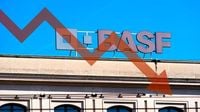Investors are feeling anxious about BASF's stock performance after a recent recovery from a crash low of 37.40 EUR. Between April 7 and April 26, 2025, the DAX-listed stock managed to rebound to 45.88 EUR. However, the last three trading days have shown signs of weakness, particularly as the stock has repeatedly failed to surpass the critical moving averages of EMA 50 (45.76 EUR) and EMA 200 (45.96 EUR), which are currently aligned closely. The XETRA closing price on May 1, 2025, was 44.63 EUR, and the Tradegate price on the morning of May 2, 2025, was 44.92 EUR, indicating a narrow trading range ahead of the next decision point.
If the BASF stock falls below the zone between 43.80 and 44.11 EUR, it would trigger a significant sell signal. Such a movement could lead to testing support levels at 41.32 EUR and 40.17 EUR, and potentially revisit the April low of 37.40 EUR. Conversely, the bulls have their sights set on the 46 EUR mark. A stable breakout above the EMA 50 and EMA 200 could initiate a new upward momentum for BASF's stock price, with initial targets lying within the gap between 46.58 EUR and 47.38 EUR, followed by another resistance zone just below 48.60 EUR. Should further bullish signals materialize, a test of the double top at the 55 EUR mark may also become a possibility.
Currently, the indicators are sending mixed signals. The RSI stands at 48.98 points, slightly below the neutral 50 line, indicating no clear trend. Meanwhile, the Chaikin Money Flow is at -0.06, suggesting ongoing but not excessive capital outflows, which remains a concern in an already strained technical environment.
In the first quarter of 2025, BASF's revenue decreased by 0.9 percent to 17.4 billion EUR compared to the same period last year. All business areas experienced declines, with EBIT dropping by 29.2 percent to 1.197 billion EUR. The earnings per share after taxes, depreciation, and adjustments stood at 1.57 EUR, reflecting a 6.3 percent decrease. Additionally, cash flow and free cash flow fell significantly into negative territory, which is unlikely to boost investor sentiment.
Despite these challenges, CFO Dirk Elvermann stated that the direct impacts of US tariffs on BASF would likely be manageable, as the company produces locally for regional markets. The outlook for 2025 remains stable, with an EBITDA before special items projected in the range of 8.0 to 8.4 billion EUR and a free cash flow of 0.4 to 0.8 billion EUR.
However, the BASF stock has struggled to maintain the important 200-day line following the quarterly figures. Investors are particularly focused on developments surrounding this line, as reactions often occur in the wake of quarterly reports. If the stock fails to surpass the 200-day line, it may further decline.
For those holding BASF shares as of May 2, 2025, a dividend will be distributed next week. However, any investors purchasing the stock after this date will not be entitled to the dividend for this year. This upcoming dividend adjustment could further complicate the stock's outlook, especially given the less than favorable chart patterns and fundamental numbers.
In terms of market analysis, UBS has maintained a 'Neutral' rating for BASF with a target price of 47 EUR. Meanwhile, JP Morgan Chase & Co. has categorized the stock as 'Underweight' with a price target of 45 EUR. Analyst Chetan Udeshi noted that the chemical group's first quarter results largely met expectations, but the overall uncertainty has increased.
As of May 2, 2025, the BASF stock was down by 1.2 percent to 44.08 EUR during XETRA trading. Despite this decrease, there is still an upside potential of 2.09 percent compared to the set target price. Throughout the trading session, 1,077,765 BASF shares were available for purchase or sale via XETRA, and the stock has seen a year-to-date increase of 3.8 percent.
In the broader market context, investor sentiment was buoyed by signals of rapprochement between the USA and China regarding the tariff dispute. On May 2, 2025, the DAX index increased by up to 1.8 percent to reach 22,897 points. The EuroStoxx50 also gained 1.5 percent. Reports indicated that China expressed willingness to discuss the tariff conflict, which could potentially ease tensions and positively impact stock prices.
In light of these developments, BASF's performance remains under scrutiny. Analysts suggest that investors may need to exercise caution in the short term while keeping an eye on potential long-term growth. The BÖRSE ONLINE editorial team sees a long-term potential for BASF stock to reach up to 61.80 EUR, contingent on improving market conditions and a stabilization of the global economy.
As the market continues to navigate through these uncertainties, BASF's ability to adapt to changing conditions and maintain investor confidence will be crucial for its future performance.


